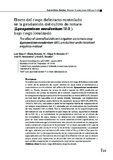Efecto del riego deficitario controlado en la producción del cultivo de tomate (Lycopersicon esculentum Mill.) bajo riego localizado
Fecha
2009-09-09Palabras Clave
Tomate, Riego deficitario, Riego localizadoTomato, Defficiting irrigation, Localizated irrigation
Metadatos
Mostrar el registro completo del ítemResumen
Se realizó una investigación para evaluar el efecto del riego deficitario controlado a través de la aplicación de cuatro láminas de agua sobre el rendimiento y características morfométricas del cultivo de tomate (Lycopersicon esculentum Mill.) cv. Presto, durante los meses de abril a agosto de 2005,
producido en condiciones de campo en terrenos de la estación experimental del Instituto de Investigaciones Agropecuarias de la Universidad de Los Andes (IIAP ULA), ubicado en San Juan de Lagunillas en el estado Mérida, Venezuela. Los tratamientos consistieron en aplicar cuatro láminas de reposición de agua 100% ETc, 80% ETc, 70% ETc, 60% ETc., calculados a partir de los registros diarios de evaporación en un tanque evaporímetro tipo A y afectados por el
coeficientes Kp (Coeficiente de tina, método FAo 33,1980). Para la determinación de la evapotranspiración del tomate se usó el coeficiente Kc por etapa de cultivo, siguiendo el método de la FAo 56, y se consideraron las precipitaciones efectivas en el cálculo de las necesidades de agua. Aunque las diferencias por rendimiento, tamaño y peso de fruto entre tratamientos no fueron estadísticamente significativas, los resultados indicaron que el rendimiento más
elevado de tomate en las categorías total y comercial se logró con el tratamiento “T2” es decir afectando la ETc por el coeficiente de 0,80 con 62,71 Tn haˉ¹ y 53,16 Tn haˉ¹ respectivamente. La cantidad de agua aplicada por hectárea osciló entre 3.602 m³/ha y 2.530 m³/ha para los coeficientes de 1 y 0,6
respectivamente. En la comparación de los volúmenes de agua aplicados por hectárea se observó que el coeficiente 0,8 con que se obtuvo mayor producción, represento un ahorro del 22% con relación al coeficiente 1, que vendría a representar el requerimiento total de la evapotranspiración.
Colecciones
Información Adicional
| Otros Títulos | The effect of controlled deficient irrigation on tomato crop (Lycopersicon esculetum Mill.) production under localized irrigation method |
| Correo Electrónico | razuri@ula.ve rjose@ula.ve edroca@ula.ve |
| ISSN | 1315-3919 |
| Resumen en otro Idioma | A research was made to evaluate the effect of controlled deficient irrigation by applying tour sheet layers of water over the yield and morphometric characteristics of tomato crop (Lycopersicon esculentum Mill.) cv. Presto, produced on open field conditions at the Experimental Station of the Instituto de Investigaciones Agropecuarias de la Universidad de Los Andes (IIAP ULA) since April to August, 2005 in San Juan de Lagunillas, Mérida State, Venezuela. The treatments consisted on applying four sheet layers of water replacements at 100% ETc, 80%ETc, 70%ETc, and 60% Etc, all calculated from daily evaporation records on an evapotranspirative type A pan and each one affected by the Kp coefficients (pan coefficient, FAo 33, 1980 method). To determine the evapotranspiration of tomato; it was used the Kc coefficient at each stage of the crop, following FAo 56 method, and there were considered the effective precipitations to calculate the water needs. Although the differences of yielding, size and weight of the fruit among the treatments were not statistically significant, the results showed that the higher yielding of tomato in the total and commercial categories was achieved with the “T2” treatment, that is affecting the Etc by the 0,80 coefficient with 62,71 Ton hec-1 and 53,16 Ton hec-1 respectively. The amount of water applied per hectare oscillated between 3.602 m3/ha and 2.530 m3/ha for the coefficient 1 and 0, 6 respectively. At the comparison of water volumes applied per hectares, it was observed that the 0, 8 coefficient which it obtained the higher production, it represented a 22% of savings in relation to the 1 coefficient, so it would become and represent the total evapotranspiration requirement. |
| Colación | 31-48 |
| Periodicidad | anual |
| Publicación Electrónica | Revista Agricultura Andina |
| Sección | Revista Agricultura Andina: Artículos |






